 Cavs Archive
Cavs Archive  Alternate Universe #1: Jordan Misses "The Shot"
Alternate Universe #1: Jordan Misses "The Shot"
 It’s a plot device typically reserved for sci-fi movies, comic books, and quantum physics classes: the Alternate Universe. But what happens when we apply the theory of parallel realities to something a little less fantastic-- like, say, Cleveland sports? Can the slightest alteration of a single historic event dramatically rewrite more than a half-century of woe? Is there a world out there where Cleveland is perhaps not the hotbed of heartbreak?
It’s a plot device typically reserved for sci-fi movies, comic books, and quantum physics classes: the Alternate Universe. But what happens when we apply the theory of parallel realities to something a little less fantastic-- like, say, Cleveland sports? Can the slightest alteration of a single historic event dramatically rewrite more than a half-century of woe? Is there a world out there where Cleveland is perhaps not the hotbed of heartbreak?
This series of revisionist, highly unnecessary columns will seek to answer those questions—lazily and unscientifically-- by exploring a collection of Alternate Universes created by the tiniest manipulation of some fairly memorable plays from Cleveland sports history. We begin 22 years ago—May 7, 1989—at the Richfield Coliseum. It’s the final seconds of the decisive Game 5 of the NBA Eastern Conference Quarterfinals, and the Chicago Bulls are trailing 100-99, counting on Michael Jordan to save their season. Craig Ehlo and the Cavs have other ideas.
Pregame: The Science of “The Shot(s)”
Suffice it to say, Ehlo has played this one over in his head a few thousand times—almost as often as ESPN rebroadcasts it. For Jordan, arguably the greatest athlete of the 20th century, it became the signature highlight of a highlight-filled career. Yup, the greatest play by the world’s greatest player took place on what is now a stretch of nondescript farmland in Richfield, Ohio. In the grand scheme, though, the entire legacy of “The Shot” hinges on the details of a single split second—the rotation of the ball, the give of the rim, the breathing of the nervous fans at the Coliseum. And according to at least one scientific theory, just because we all saw it go in, doesn’t mean that’s the only way it happened. Yeah, here comes the part where I pretend to grasp quantum physics.
Back in 1957, Princeton physicist Hugh Everett III introduced what would come to be known as the “many-worlds interpretation” (MWI)—which concludes, among other things, that any event that could potentially happen does happen. It’s just our limited human perceptions that keep us from seeing all those infinite possibilities realized. Combine this concept with the “butterfly effect” from chaos theory (a small change in a system bringing about much greater change down the line), and you’ve got yourself the building blocks behind that old Cleveland catchphrase, “What if?”
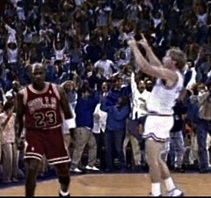 So, based on Everett’s theory, there could actually be a real, tangible world in which Brad Sellars inbounded the ball to Michael Jordan, Jordan created separation from Ehlo, Jordan launched a jumper at the buzzer, and the ball rattled around the iron and spun out. No good! Cavs win! Conveniently, this blissful alternate reality was actually digitally recreated for a Gatorade commercial a few years back, allowing us to see a rejoicing Ehlo and devastated Jordan for a fleeting moment before Gatorade’s thirst-quenching magic set everything right again.
So, based on Everett’s theory, there could actually be a real, tangible world in which Brad Sellars inbounded the ball to Michael Jordan, Jordan created separation from Ehlo, Jordan launched a jumper at the buzzer, and the ball rattled around the iron and spun out. No good! Cavs win! Conveniently, this blissful alternate reality was actually digitally recreated for a Gatorade commercial a few years back, allowing us to see a rejoicing Ehlo and devastated Jordan for a fleeting moment before Gatorade’s thirst-quenching magic set everything right again.
Question is, what if we could step through the looking class and live in that parallel universe for a bit longer? How many other dominos would fall if Michael Jordan actually missed The Shot? Well, here is a look at one such alternate universe—with "The Miss" as the origin point. And remember, I can't be wrong about any of this. Because as long as it could have happened, in this case, it freakin' happened.
Domino #1: Cavs Win, Bulls Lose
In the short term, it’s as simple as that. Jordan’s shot was a buzzer beater, so there weren’t going to be any further repercussions in Game Five itself. Since "The Shot" rims out, Cleveland wins the game and the series, advancing them to an Eastern Conference semi-final showdown with the New York Knicks. The win also avenges the Cavs’ Game Five loss to the Bulls in Chicago in Round One a year earlier and puts Cleveland in the second round of the playoffs for the first time since the Miracle of Richfield in 1976. Since Cleveland beat Chicago all six times they met in the '88-'89 regular season, it’s hardly a shocker that they took this series. They were the better team, after all. But it’s a monkey off the back, nonetheless.
The next morning’s Plain Dealer concentrates on the inspiring performance of Craig Ehlo, who overcame an ankle injury that had cost him a game earlier in the series, and wound up putting home the game-winning shot on a drive in the lane with three seconds to play. Nationally, the focus falls on the 25 year-old Michael Jordan, whose five pro seasons have now yielded only one playoff series win.
“This has to be considered a major step back for Jordan,” say the Sports Reporters, “as his drive toward getting another crack at the mighty Pistons fell feebly short, just like his last-second jump shot in Game Five against Cleveland.”
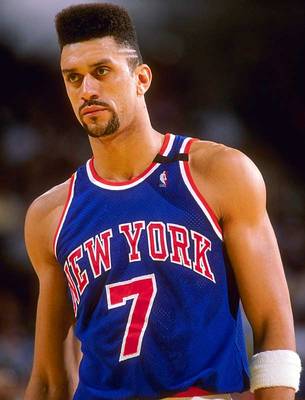 Domino #2: Bring on the Knicks
Domino #2: Bring on the Knicks
Air Jordan is home, and now it’s finally time for Lenny Wilkens’ supremely talented club to take the next step. Along with Ehlo’s ankle, point guard Mark Price is battling a groin injury, but the Cavaliers have home court advantage again in the conference semi-finals, as the rested Knickerbockers come to town, fresh off a sweep of the 76ers. These are the Knicks of Patrick Ewing, Mark Jackson, Charles Oakley, Gerald Wilkins, and of course, Kenny “Sky” Walker (pictured). They’re a tough nosed bunch, but the Cavs have more than enough weapons to counter with—including Brad Daugherty, Larry Nance, and Hot Rod Williams in the front court, Mark Price running the offense, and the team’s most electric scorer, Ron Harper—who averaged 20 points a game in the Bulls series. The Knicks and Cavs split their four meetings during the regular season, and the trend follows suit in the playoffs, as Cleveland—led by Harper—takes the series in seven, setting up a Conference Finals showdown with the Bad Boys of Detroit.
Domino #3: Re-Assessing Ron
Nothing was going to stop the '88-'89 Pistons from winning the NBA Championship, including the fast-rising Cavs. The two teams had split six games during the regular season, but Detroit had won the last three meetings, and they maintain their home court dominance in this alternate universe version of the Conference Finals, winning it 4 games to 2. In the series, the Bad Boys are able to outmuscle Daugherty and push around Price, but Harper again excels, becoming the team’s go-to offensive weapon in crunch time. He is making a national name for himself.
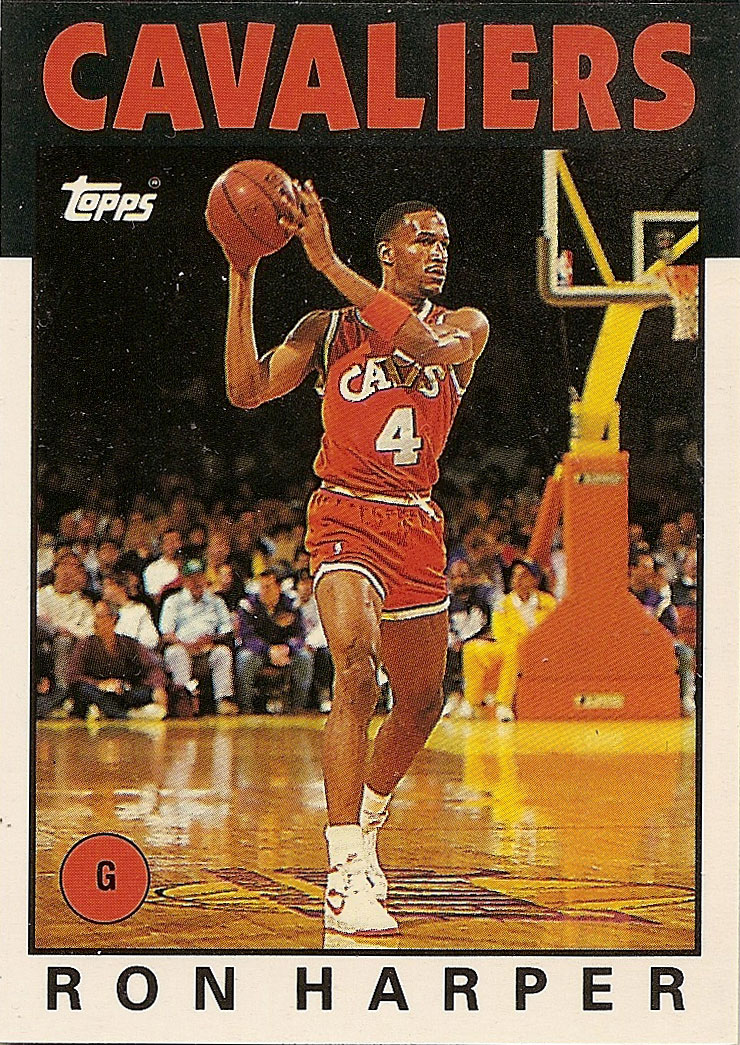 Early the following season, however, Cavs GM Wayne Embry still isn’t much of a Harper fan-- despite the fact that Ron’s a fellow Miami of Ohio grad who’s currently leading Cleveland in scoring at 23 PPG through the first two weeks. There are apparently character concerns with the 25 year-old—particularly with his choice of friends. Depending on which gossiping locker room attendant you ask, Harper is either sleeping with Embry’s wife or owner Gordon Gund’s daughter, and thus, the front office wants him gone (yes, Delonte-gate was not the first time we’ve picked a ridiculous Jerry Springer explanation for the an otherwise inexplicable situation).
Early the following season, however, Cavs GM Wayne Embry still isn’t much of a Harper fan-- despite the fact that Ron’s a fellow Miami of Ohio grad who’s currently leading Cleveland in scoring at 23 PPG through the first two weeks. There are apparently character concerns with the 25 year-old—particularly with his choice of friends. Depending on which gossiping locker room attendant you ask, Harper is either sleeping with Embry’s wife or owner Gordon Gund’s daughter, and thus, the front office wants him gone (yes, Delonte-gate was not the first time we’ve picked a ridiculous Jerry Springer explanation for the an otherwise inexplicable situation).
In any case, Harper is hesitantly put on the trade block, and the desperate L.A. Clippers are interested. They just drafted an elite #1 pick, Duke’s Danny Ferry, who has chosen to play in Europe rather than suit up with the Clips. They tempt Embry with the idea of Ferry being the next Larry Bird—the guy to help the Cavs get past the Pistons.
In this alternate universe, however, Embry balks at pulling the trigger. Despite his personal feelings, he can’t help but think of last season’s playoffs, when Harper made it clear that he was the most dynamic weapon the Cavs had against the suffocating Detroit defense. The risk of trading for Ferry—and including TWO future first round picks as Los Angeles demanded—seemed far too risky. Ron Harper would remain a Cavalier.
In 2010, the Ron Harper of our universe (who won 5 NBA titles in his career with the Bulls and Lakers) told the Plain Dealer that if he had stayed in Cleveland... "I think we would have won more than one ring. We would have had to beat Chicago, we would have had to beat Detroit, we would have had to beat the Celtics. There were a few teams we would have had to play against, but I felt that we were young enough and naive [enough] to feel that we were that good."
Domino #4: Delayed Jordan
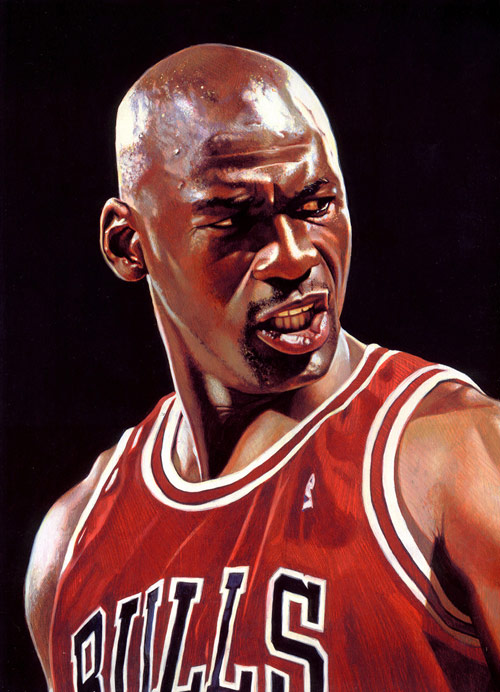 As in our own reality, the Bulls fire Doug Collins after the '88-'89 season and hire Phil Jackson to take over. An angry, motivated Jordan and an improving Scottie Pippen elevate Chicago to a second place finish in the Central in 1990. Meanwhile, the Cavs are hindered by injuries to Daugherty and Nance early in the ‘89-'90 campaign. In this alternate universe, however, Ron Harper doesn’t go to Los Angeles and destroy his knee, meaning he is there to blossom as the Cavs’ top scorer. And with Nance and Daugherty healthy for the postseason, Cleveland now has the size, firepower, and athleticism to challenge Jordan and the Bulls once again. As the 6-seed, they meet 3-seeded Chicago in the playoffs for a third straight year. A rejuvenated Daugherty (who averaged 22 points in the 1990 playoffs in our universe) is too much for Bill Cartwright to handle. Meanwhile, Nance and Williams keep Pippen in check, while Harper and Ehlo do their best to keep Jordan at least somewhat contained. The series goes seven, and the Cavs pull the upset as Jordan—perhaps forcing things a bit after last year’s disappointing finish—can’t overcome Cleveland’s depth.
As in our own reality, the Bulls fire Doug Collins after the '88-'89 season and hire Phil Jackson to take over. An angry, motivated Jordan and an improving Scottie Pippen elevate Chicago to a second place finish in the Central in 1990. Meanwhile, the Cavs are hindered by injuries to Daugherty and Nance early in the ‘89-'90 campaign. In this alternate universe, however, Ron Harper doesn’t go to Los Angeles and destroy his knee, meaning he is there to blossom as the Cavs’ top scorer. And with Nance and Daugherty healthy for the postseason, Cleveland now has the size, firepower, and athleticism to challenge Jordan and the Bulls once again. As the 6-seed, they meet 3-seeded Chicago in the playoffs for a third straight year. A rejuvenated Daugherty (who averaged 22 points in the 1990 playoffs in our universe) is too much for Bill Cartwright to handle. Meanwhile, Nance and Williams keep Pippen in check, while Harper and Ehlo do their best to keep Jordan at least somewhat contained. The series goes seven, and the Cavs pull the upset as Jordan—perhaps forcing things a bit after last year’s disappointing finish—can’t overcome Cleveland’s depth.
Ousted in the first round yet again, and without the two valuable Conference Finals battles with the Pistons under their belts, Jordan and the Bulls have their path to greatness at least temporarily derailed. In time, they’ll get their rings, but without “The Shot”—in this version of events-- Chicago's run doesn’t begin for several more years.
Domino #5: Bad News for the Birmingham Barons (and the Houston Rockets)
As a further consequence of the Bulls delayed rise to greatness, Michael Jordan’s response to the tragic death of his father is different, as well. He has more to prove on the court, having only just entered into the conversation as the greatest of all time. And while he considers the possibility of one day trying his hand at baseball, the timing isn’t right. The Bulls take the court—with #23 still in the fold—in ’94 and ’95, erasing the repeat title run of the Houston Rockets from the record book.
Domino #6: Depth, Youth, Triumph
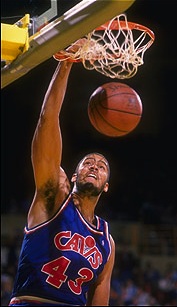 At the start of the ‘90s, it’s the Pistons, rather than the Bulls, that take their place as Cleveland’s biggest obstacle, eliminating them repeatedly from the postseason. But unlike in our universe, the Cavs are better equipped to handle the fragility of Price, Daugherty, Williams, and Nance as a new window of opportunity opens in the years that follow. For one thing, Harper is there, moving Ehlo to the bench and creating considerable scoring depth. Second, Danny Ferry is NOT there—replaced instead by a pair of first round picks in 1990 and 1992 that would otherwise have gone to Los Angeles (names on the board for those picks include: Toni Kukoc, Dee Brown, Jayson Williams, Elden Campbell, P.J. Brown, and Brent Price). These young role players help sustain the team’s success and allow Lenny Wilkens to rest his starters more to prevent further injuries.
At the start of the ‘90s, it’s the Pistons, rather than the Bulls, that take their place as Cleveland’s biggest obstacle, eliminating them repeatedly from the postseason. But unlike in our universe, the Cavs are better equipped to handle the fragility of Price, Daugherty, Williams, and Nance as a new window of opportunity opens in the years that follow. For one thing, Harper is there, moving Ehlo to the bench and creating considerable scoring depth. Second, Danny Ferry is NOT there—replaced instead by a pair of first round picks in 1990 and 1992 that would otherwise have gone to Los Angeles (names on the board for those picks include: Toni Kukoc, Dee Brown, Jayson Williams, Elden Campbell, P.J. Brown, and Brent Price). These young role players help sustain the team’s success and allow Lenny Wilkens to rest his starters more to prevent further injuries.
The ultimate payoff comes in the 1992 playoffs, when—after disposing of Larry Bird and the Celtics (just as they did in our universe)—the fully armed Cavs rip the Bulls one last time, and go on to defeat the Portland Trailblazers in a six game series to win the franchise’s first NBA title.
Daugherty is the difference in the Finals, dominating the Blazers’ Kevin Duckworth and taking home the MVP trophy.
It’s a brief moment of glory for the Cavaliers. Nance and Daugherty only have a couple seasons left in them, and by the mid ‘90s, Michael Jordan has willed Chicago to the top of the Eastern Conference, finally eliminating Cleveland in the 1993 playoffs, and doing the same in 1994.
Mike Fratello never coaches the Cavs. Instead, Wilkens voluntarily resigns his post after the 1995 postseason, as the team looks to rebuild and create some of the old Coliseum magic in their new downtown digs.
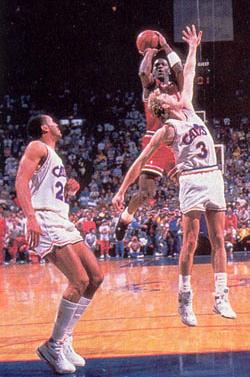
Domino #7: Legacy
One play was never going to prevent Michael Jordan from becoming the greatest player of his generation. And one huge win wasn’t going to vault the ‘90s Cavs into the team of the decade. But in an alternate universe where “The Shot” was no good, things would most certainly be different. Sure, in 99 universes out of 100, we probably still never win a championship (I just chose one of the good universes, I guess). But at least a few things can be agreed upon about any universe where Jordan missed “The Shot.”
1. We’d have a Cavs-Knicks series to look back on.
2. Michael Jordan highlight montages would look a lot different.
3. Craig Ehlo would be a lot less famous.
4. Cleveland would have at least one less "What If?" to wonder about (but maybe a whole bunch of new ones).
- NBA Announces 2013-2014 Schedule
- Browns Ink Sharknado
- Sharknado A No-Show For Rookie Camp
- Trent Richardson Out Until Training Camp
- Browns Sign Brandon Jackson
- Carrasco Suspended Eight Games
- Browns Add to Wide Receiver Depth with David Nelson
- Browns Need to Learn from Past Draft Mistakes
- Browns Release Chris Gocong and Usama Young
- Browns Missing on Grimes Disappointing, But Not The End
The TCF Forums
- Movies coming out
rebelwithoutaclue (Tuesday, January 21 2014 12:56 PM) - 2015 Recruiting
jclvd_23 (Tuesday, January 21 2014 12:38 PM) - The 2014 Offseason Thread
Larvell Blanks (Tuesday, January 21 2014 12:25 PM) - Official- Browns Coach Search/Rumors
Larvell Blanks (Tuesday, January 21 2014 11:53 AM) - Chris Grant's first 3 drafts
Kingpin74 (Tuesday, January 21 2014 10:13 AM) - Mike Brown
YahooFanChicago (Monday, January 20 2014 11:15 PM) - 2014 Hoops Hockey Hijinx
jpd1224 (Monday, January 20 2014 4:44 PM) - 2014 Recruiting
jclvd_23 (Monday, January 20 2014 2:26 PM) - Wish List - #4 Pick
Hikohadon (Monday, January 20 2014 1:26 PM) - #1 overall pick Anthony Bennett
TouchEmAllTime (Sunday, January 19 2014 1:28 PM)


